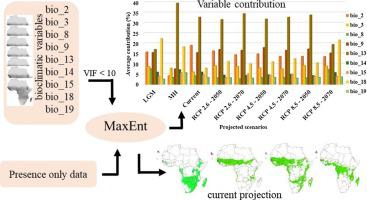Aquatic Botany ( IF 1.8 ) Pub Date : 2021-06-12 , DOI: 10.1016/j.aquabot.2021.103416 John M. Nzei , Boniface K. Ngarega , Virginia M. Mwanzia , Paul M. Musili , Qing-Feng Wang , Jin-Ming Chen

|
Mapping and modeling suitable habitat and distribution of aquatic species is important to help assess the impact of factors such as climate change in affecting the shift, decline, or expansion of species habitat ranges. In Africa, the distribution of water lily (Nymphaea) species is geographically varied and the habitats suitable for individual species are prone to effects of global warming, though only limited conservation measures have been taken to date in aquatic environments. In this study, four widely distributed water lily species (N. nouchali, N. micrantha, N. lotus, and N. heudelotii) were modeled using MaxEnt which highlighted the individual species’ suitable climatic distribution. The current distribution indicates a partial distribution of N. nouchali in West Africa unlike N. micrantha, N. lotus, and, N. heudelotii. Nymphaea lotus displays wider distribution in West, East, and parts of South African countries including their coastlines compared to all other species. Nymphaea nouchali indicates dense distribution in countries South of Africa while N. micrantha and N. heudelotii in West African countries. Greater habitat changes were noticed between the future and the past projection due to limited range expansion in 2.6, 4.5, and 8.5 (2050) Representative Concentration Pathways (RCPs) in almost all species. The species’ suitable habitat distribution was mainly influenced by nine variables, mostly the temperature and precipitation variables. This study provides projections of future climatic scenarios potentially influencing the distribution of Nymphaea species in Africa, which may be useful for the ongoing conservation and management of these plants especially in areas loosing suitable climatic conditions.
中文翻译:

非洲四种睡莲(睡莲)的过去、现在和未来分布模型表明气候变化中不同的适宜栖息地和分布
绘制合适的栖息地和水生物种分布图和建模对于帮助评估气候变化等因素对物种栖息地范围的转移、下降或扩大的影响非常重要。在非洲,睡莲 ( Nymphaea ) 物种的分布在地理上各不相同,适合单个物种的栖息地容易受到全球变暖的影响,尽管迄今为止仅对水生环境采取了有限的保护措施。在这项研究中,四种广泛分布的睡莲物种(N. nouchali、N. micrantha、N. lotus和N. heudelotii) 使用 MaxEnt 建模,突出了单个物种的适宜气候分布。目前的分布表明,与N. micrantha、N. lotus和N. heudelotii不同,N . nouchali在西非有部分分布。与所有其他物种相比,睡莲在南非国家的西部、东部和部分地区(包括其海岸线)的分布范围更广。Nymphaea nouchali表明在非洲南部国家密集分布,而N. micrantha和N. heudelotii在西非国家。由于几乎所有物种的 2.6、4.5 和 8.5(2050)代表性浓度途径 (RCP) 的范围扩展有限,因此在未来和过去预测之间注意到更大的栖息地变化。该物种的适宜栖息地分布主要受九个变量的影响,主要是温度和降水变量。这项研究提供了对可能影响非洲睡莲物种分布的未来气候情景的预测,这可能有助于这些植物的持续保护和管理,尤其是在失去适宜气候条件的地区。


























 京公网安备 11010802027423号
京公网安备 11010802027423号